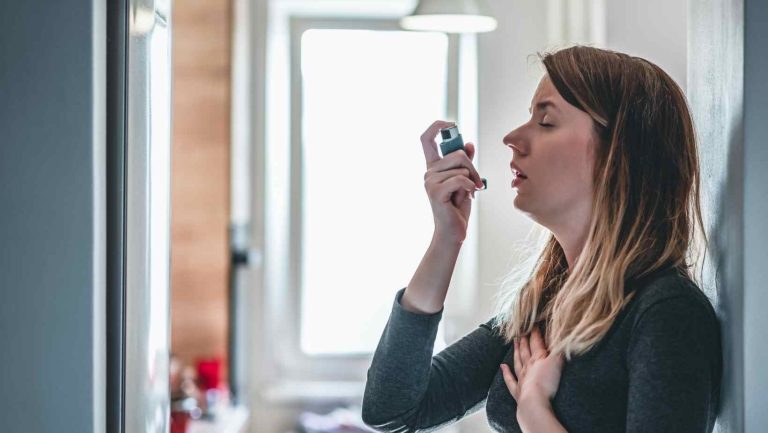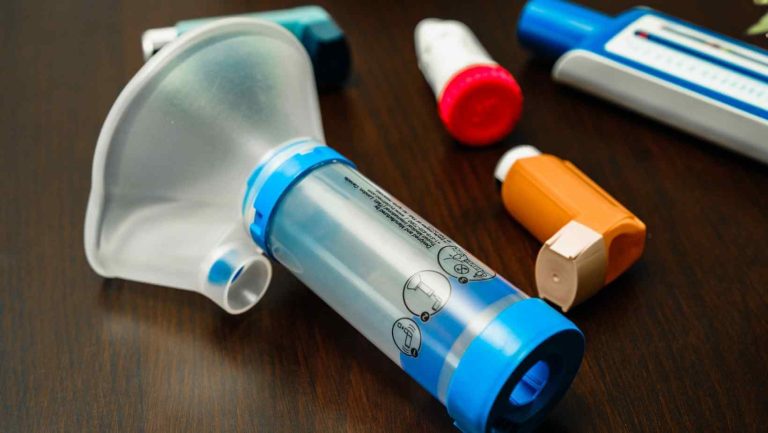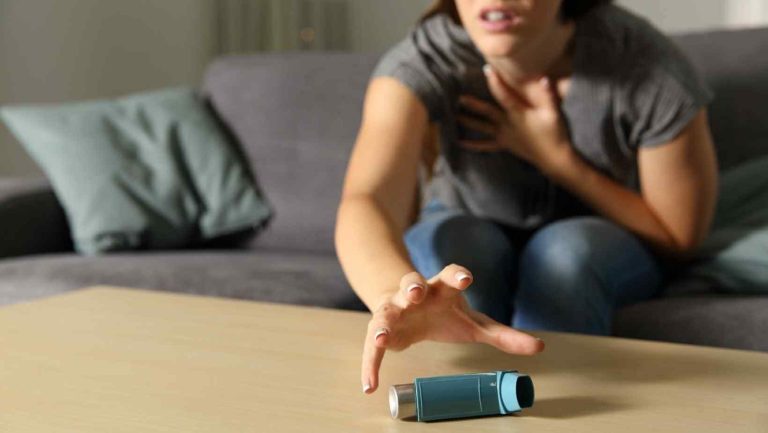Asthma First Aid

Asthma First Aid
Nearly 2.7 million people in Australia have asthma. That’s just above 10.7% of the population. Within the adult population, more females have asthma than males, but in children, the rate is relatively even between males and females.
Asthma can look different in each individual person.
If you have been diagnosed with asthma you are likely to have been prescribed inhalers, and maybe some other medications like steroids.
Asthma is a chronic lung condition. When asthma flares, the airways become inflamed and produce more mucous than usual and the smooth muscle surrounding the airways constricts, making the airway much smaller.
There is no cure for asthma at this time but it can be successfully managed and there are a lot of treatment options.
First Aid for Asthma
There are two main asthma inhalers that are prescribed to manage asthma, and these are the most likely medications to be used in an emergency with asthma.
- Inhaled steroids (often purple, red or brown inhaler)
- Inhaled ventolin (or blue inhaler)
Inhaled steroids are for people that need ongoing help managing their asthma.
1 in 3 people with asthma use medication daily, but others may only have to use their asthma puffers when they become symptomatic. Sometimes asthma will only flair with allergies or induced by exercise.
You will also be given an asthma action plan. Action plans allow yourself and others to have a clear plan of action and medication to give if emergency strikes.
What are the symptoms of an asthma?
- Breathing difficulty
- Chest pain or tightness
- Wheeze
- Persistent cough
- Night time cough
Allergy induced asthma
Allergies are a common trigger of asthma symptoms.
Pollens and grasses can be difficult to avoid, as pollen travels and the grasses we see in Australia can change in each location every year.
Skin prick tests can show which pollens you are allergic to, and in turn may trigger asthma.
Common asthma triggers are:
- Viruses or colds
- Allergens such as dustmite
- Pollens and grasses
- Exercise
Asthma Symptoms
Mild/moderate symptoms
- Minor difficulty breathing
- Able to talk in full sentences
- Able to walk/move around
- May have a cough or wheeze
Severe symptoms
- Obvious difficulty breathing
- Cant speak full sentences
- Skin sucking inward at the base of the neck &/or ribs
- May have a cough or wheeze (however they may be silent)
- Blue reliever medication not lasting as long as it should.
Life threatening symptoms
- Gasping for breath
- Unable to speak 1-2 words
- Exhausted
- Confused
- Colour change – blue tinge
- Collapse
- May not have wheeze anymore (no air entry)
- Not responding to blue reliever medication at all

Asthma first aid
An asthma flare up is also known as an asthma attack.
During an asthma attack, symptoms of asthma will get worse. The casualty may have noisy breathing, an audible wheeze, have a tight chest or be coughing persistently.
It is important to remember, that if you are unsure if the casualty needs the blue reliever medication or not, you can still give the medicine with no ill effects. If in doubt, it is best to just administer asthma first aid.
First Aid Training
The following is an action plan to follow depending on what symptoms the casualty has and how severe the symptoms are.
Asthma first aid steps:
- Sit the person down
- Keep calm
- Stay with them
- Retrieve the blue reliever puffer and spacer
- Shake the puffer
- Make sure the casualty has a good seal with their mouth around the puffer
- Administer one puff of the blue inhaler into the spacer
- Ask them to take 4 breaths through the spacer
- Repeat until a total of 4 puffs and 16 breaths have been taken
- Wait 4 minutes
- If there is no improvement, repeat from step 7.
- If breathing continues the same or worse after the second round of treatment, call an ambulance
- Keep giving 4 seperatre puffs every 4 minutes until the ambulance arrives
- If the casualty stops breathing at any time, start CPR and make sure an ambulance is on its way

There may be an occasion where someone is having their first asthma attack, and they do not have inhaled medication or an action plan.
In this situation:
- Call an ambulance if they are showing any of the signs of severe to life threatening symptoms.
- Stay with them
- The casualty may be having an allergic reaction to food, medication or an insect bite. If this is the case, give the adrenalin autoinjector first, call an ambulance, then administer the reliever if they have one
If a spacer is not available, ask the casualty to take the puff straight from the inhaler and breath in deeply and slowly over a few seconds if they can.
If you are not confident in how to deal with an asthma attack, look at gaining your first aid certificate. We extensively cover asthma symptoms and how to respond in an asthma emergency, as well as practicing with an inhaler and spacer.
Want more? We’ve got you covered…
Our Baby First Aid Courses
Our baby first aid courses are available in person in your home and online. We run classes in your home with groups of 2, 4 or up to 10 in Sydney & Melbourne and you can book in 3 easy steps!
- Pick your class
- Follow the prompts to purchase
- We will contact you within 24 hours to lock in your date of choice
Our First Aid Certificate Courses
We run most of the popular first aid courses Australia wide. HLTAID011 Provide First Aid, HLTAID009 Provide CPR, HLTAID012 Provide First Aid in an Education & Care Setting, RAMOAP (anaphylaxis), Mental Health first aid and CPR/LVR to name a few.
Book your public spot online or contact us if you have a group of 5+ people for onsite training.
Here are some other resources you may enjoy!
FREE GUIDE: Your Virtual Baby First Aid Kit
FREE GUIDE: Introducing Common Allergy Foods & Allergic Reactions
FREE Workplace Emergency Preparedness Plan: Grab this at the bottom of every page!
Follow for baby & child first aid and allergy info and tips on Instagram, TikTok & Facebook all @thenestcpr
